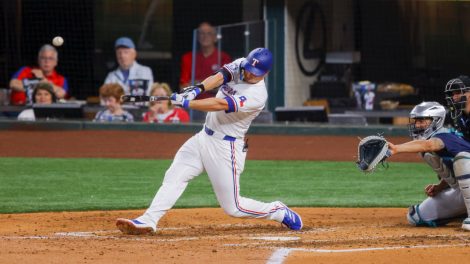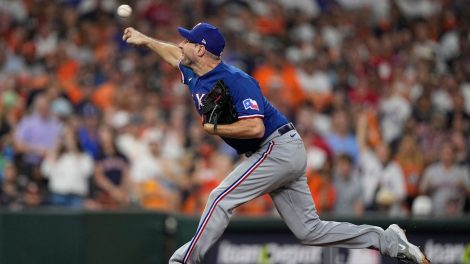TORONTO — Josh Donaldson hit one of the most memorable home runs in recent Toronto Blue Jays history Tuesday night, a three-run walk-off to right field off of Chicago White Sox closer David Robertson. Here’s how it happened.
When they know they’ll be taking an at-bat against the opposition’s closer, some hitters will go back to the clubhouse to watch video of what the pitcher has done against them in the past or what he’s been throwing lately. Some will talk to their hitting coach or another player on the bench who has experience against the closer. Donaldson didn’t do any of that.
“Nah, I know what he has. I didn’t need anyone to tell me about that and I didn’t really need any video. I remember a couple of years ago he carved me up pretty good in Oakland,” Donaldson says. “So, I’m not gonna go watch that.”
What Donaldson did watch was the first pitch of the at-bat, just to see what kind of velocity Robertson had that night. It was a 94 mph fastball down and out of the zone. Donaldson wasn’t sure what Robertson might throw next but knew the right-hander had to come back into the zone at some point, so he sat on a fastball.
Donaldson got it — 93 mph and up in the zone. The 29-year-old took a violent cut and fouled the pitch directly back into White Sox catcher Tyler Flowers’ glove.
“That was the pitch I wanted to hit,” Donaldson says. “I must have just missed it. I was actually kind of surprised that I did miss it, because I was ready for it.”
At this point Robertson gained a slight advantage in the at-bat. He could’ve gone back to the fastball — which he knew Donaldson had already struggled to make solid contact against — either in or out of the zone, or he could have used his elite curveball, which has earned a whiff 34 percent of the time he’s thrown it this season. Donaldson thought it over as he stepped out of the box, and figured Robertson would go to the curve.
“I tried to think about which pitch would surprise me or mess me up,” Donaldson says. “So I was getting myself ready for that curveball.”
Donaldson stepped back into the box but didn’t like how his feet felt, so he called time and kicked off his cleats. When he came back in Flowers flashed a series of signs — two fingers, then one, four, three, two, four — as the Blue Jays had a runner on second base who could have picked up what was called. Somewhere in that series Flowers told Robertson he wanted a fastball down.
Donaldson doesn’t time Robertson like he might with other pitchers. In most instances he’ll time a pitcher’s drive towards the plate as the moment he should begin his leg kick and get himself ready to swing. But Robertson is different.
“He’s one of those guys whose arm comes through a little later than his body,” Donaldson says. “So I don’t want to time his body coming forward to me. I want to time myself for just a split second later because his arm is going to come a click after his body.”
It was mere milliseconds after that moment, when Robertson’s arm followed through and the ball came out of his hand, that Donaldson recognized the fastball.
“I’d seen the fastball twice already so my eyes were adjusted to the speed of that pitch,” Donaldson says. “I knew pretty much as it left his hand.”
Then came the hard part. Donaldson’s body was prepared for Robertson’s curveball, which averages 84 mph, a full 10 clicks slower than the fastball velocity Robertson was featuring Tuesday night. Donaldson was anticipating having to stay back on the pitch and swing a bit later than he normally would, if the pitch was in the strike zone. But getting the fastball meant Donaldson had to make a complex physical adjustment in just hundredths of a second.
“It’s not an easy thing to do,” says Blue Jays manger John Gibbons. “If you try to hook that ball or your swing gets a little bit long, you’re either going to swing and miss or you’re probably going to pop it up.”
What makes Donaldson such a tough out is that he stays inside the ball when he’s adjusting to a higher speed or different location than he was anticipating. It can seem like his large leg kick would limit his ability to adjust, but it’s really just a timing mechanism. It’s what comes after it that matters.
“There’s a lot of leg kickers that will use the other side of the field,” Gibbons says. “The good ones can really stay inside and fire it away to the opposite field. You think about Manny Ramirez and guys like that over the years. That’s what makes [Donaldson] so effective. Leg kicks are tough to hold your consistency with. But he’s done it pretty well.”
When Donaldson saw the fastball he simply reacted. Thousands and thousands of hours of training and repetition caused his muscle memory to kick in. He took an aggressive swing at the pitch, which couldn’t have been in a better place to be hit, out and over the heart of the plate.
“A lot of your ability to react to something like that depends on how well your body’s moving,” Donaldson says. “That’s one thing I try to do everyday. I try to have a good idea of how my body’s moving that day and yesterday it was moving pretty well.”
Donaldson hammered the pitch 367 feet into the White Sox bullpen. It was the second-shortest homer he’s hit this season, but likely the most important as it gave his team a walk-off in a ninth inning that began with the Blue Jays’ win expectancy at nine percent. It was a complex piece of hitting. But, at the same time, it was inherently simple.
“I mean, is hitting a baseball hard? Yeah,” Donaldson says. “But it’s just something I do. Something I’ve been doing my entire life.”









